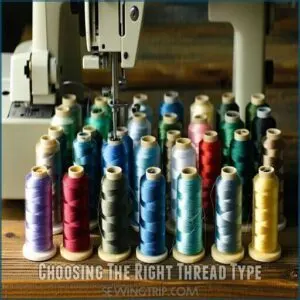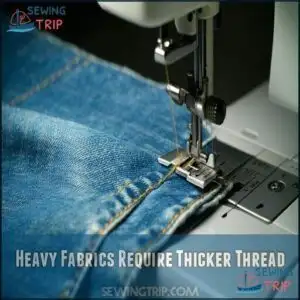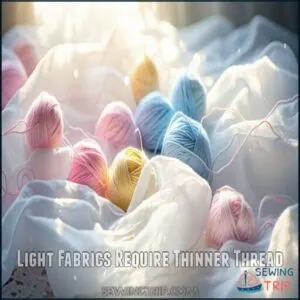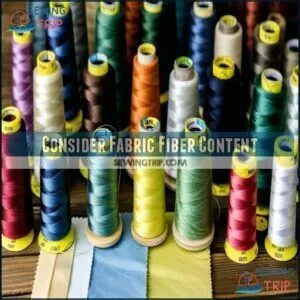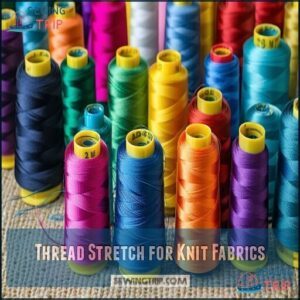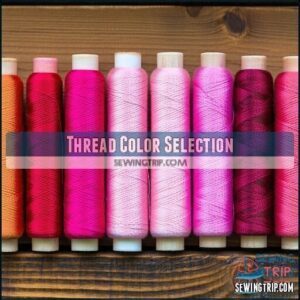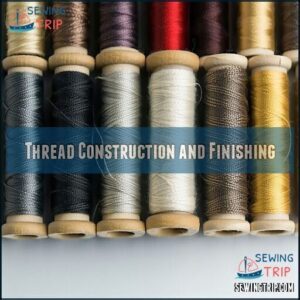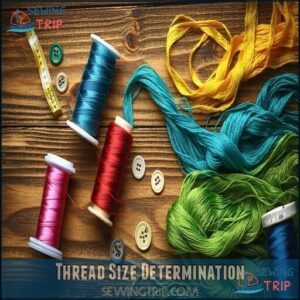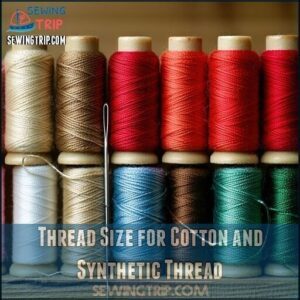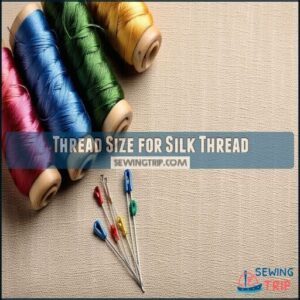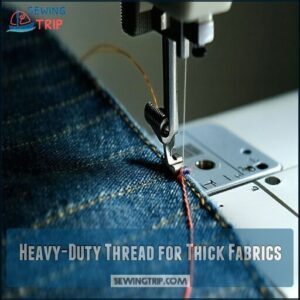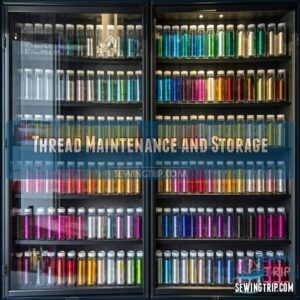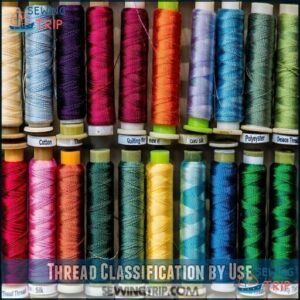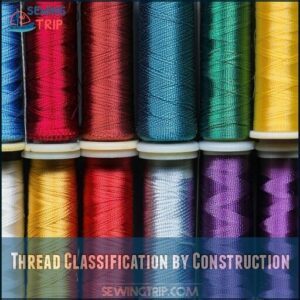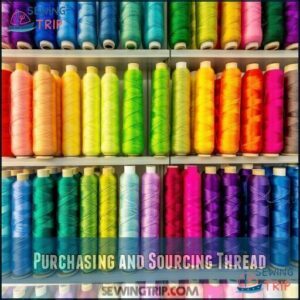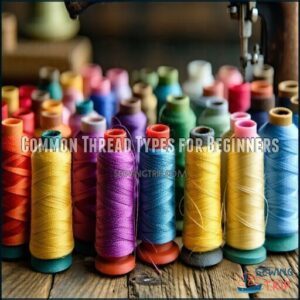This site is supported by our readers. We may earn a commission, at no cost to you, if you purchase through links.
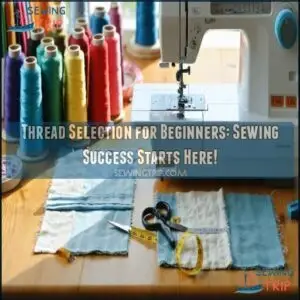
You’ll want to match your thread to your fabric – cotton threads work great for natural fabrics, while polyester gives you versatility across different materials.
Thicker threads are perfect for heavy fabrics, and thinner ones suit lighter textiles.
Color matters too: either blend with your fabric or create a bold contrast, but always test on a scrap first.
Pro tip: consider the fabric’s weight and stretch when choosing your thread, and you’ll be stitching like a pro in no time.
Ready to discover more thread selection secrets?
Table Of Contents
- Key Takeaways
- Choosing The Right Thread Type
- Matching Thread to Fabric
- Thread Color Selection
- Thread Construction and Finishing
- Thread Sizes and Types
- Thread Maintenance and Storage
- Thread Classification by Use
- Thread Classification by Construction
- Purchasing and Sourcing Thread
- Common Thread Types for Beginners
- Frequently Asked Questions (FAQs)
- Conclusion
Key Takeaways
- You’ll want to match your thread fiber to your fabric type, choosing polyester for versatility, cotton for natural fabrics, and nylon for heavy-duty projects.
- Pay attention to thread weight and size, understanding that smaller numbers mean thicker threads, and always select a thread thickness that complements your fabric’s weight.
- Test your thread color and performance on a fabric scrap first, ensuring it blends seamlessly or creates an intentional contrast without compromising stitch quality.
- Invest in high-quality thread brands like Gutermann and Coats & Clark, as they offer consistent performance and durability that will prevent frustrating breakages and uneven stitching.
Choosing The Right Thread Type
Choosing the right thread can make or break your sewing project, so it’s key to understand the basics of thread selection.
With a variety of thread types available, you’ll want to match your thread to your fabric’s specific needs to guarantee strong, beautiful stitches that stand the test of time.
Cotton Thread for Natural Fabrics
When you’re diving into cotton thread, you’ll discover a fabric matchmaker’s dream for natural fibers.
Cotton thread’s strength shines brightest on cotton and linen materials, offering unparalleled breathability and a soft, authentic finish.
Its versatile thread weight allows for everything from delicate heirloom projects to sturdy everyday wear.
Consider purchasing quality cotton thread for best results.
Pro tip: Choose high-quality cotton thread types that complement your fabric’s texture and color.
Remember, tension is key—too tight creates puckers, too loose weakens your stitches.
Store your cotton threads carefully to maintain their pristine condition.
Polyester Thread for Versatility
Polyester thread is your sewing superhero, ready to conquer any fabric challenge!
Its unbeatable durability and incredible versatility make it a must-have in your crafting arsenal.
Check out why this synthetic marvel stands out:
- Withstands repeated washing and wear
- Perfect for stretchy and woven fabrics
- Resists fading like a champ
- Handles heat with remarkable grace
Its strength contributes to overall seam durability.
Thread types don’t get more reliable than this!
Nylon Thread for Heavy Fabrics
When sewing heavy-duty projects like leather jackets or sturdy denim, nylon thread emerges as your trusty companion.
Its unmatched strength and durability make it the go-to choice for industrial and rugged applications.
| Fabric Type | Thread Performance | Best Uses |
|---|---|---|
| Denim | Excellent Durability | Jeans, Workwear |
| Leather | High Tensile Strength | Jackets, Accessories |
| Canvas | Robust Performance | Bags, Outdoor Gear |
| Upholstery | Resistance to Wear | Furniture, Industrial |
Nylon doesn’t stretch, ensuring rock-solid stitches that won’t quit.
For demanding tasks, consider using heavy duty nylon for peak results.
All-Purpose Thread for General Use
After mastering nylon thread for heavy fabrics, meet your new sewing companion: all-purpose thread.
Think of it as the Swiss Army knife in your crafting toolkit. This versatile thread adapts to almost any project with ease.
- Stretchy and heat-resistant
- Works across multiple fabric types
- Perfect for beginners
- Affordable and widely available
- Compatible with most sewing machines
Your go-to thread for everyday creativity!
Metallic Thread for Decorative Purposes
Want to add some serious sparkle to your projects?
Moving beyond basic threads, metallic threads can transform your work from simple to stunning. With their shimmering finish, these threads demand special attention.
Choose quality brands like Japan thread or purl threads for goldwork techniques.
Pro tip: use a metallic needle, loosen machine tension, and work at a slower speed. Test thread color and stitch length on scrap fabric first.
Remember, shimmer durability depends on your technique!
Matching Thread to Fabric
You’ve probably noticed that not all threads are created equal, and choosing the right one can make or break your sewing project.
When matching thread to fabric, you’ll want to think about factors like fabric weight, fiber content, and the specific demands of your project to guarantee your stitches are strong, invisible, and perfectly suited to your material.
Heavy Fabrics Require Thicker Thread
Thick fabric demands a heavyweight champion of threads.
When wrestling with denim or upholstery, your thread needs serious muscle.
Choose a thread weight that matches the fabric’s bravado—thicker threads guarantee seam strength and durability.
Grab a larger needle and adjust your machine’s tension.
Your heavy-duty project deserves threads that won’t back down from a challenging fabric fight.
Light Fabrics Require Thinner Thread
Tread lightly when working with delicate fabrics!
Choosing the right thread can make or break your project.
Here’s your game plan for lightweight materials:
- Select ultra-fine thread to preserve fabric drape
- Match thread weight to your needle size
- Prevent puckering with gentle tension adjustments
Whisper-thin threads create seamless, professional-looking delicate seams that’ll make your sewing sing.
Consider Fabric Fiber Content
When entering sewing, your thread’s fiber content is important to project success.
Different fabrics demand specific thread types, guaranteeing durability and professional results.
| Fabric Type | Recommended Thread | Compatibility | Performance |
|---|---|---|---|
| Cotton | Cotton Thread | High | Excellent |
| Synthetic | Polyester Thread | High | Strong |
| Blend | Poly-Cotton | Medium | Versatile |
| Specialty | Specific Blend | Varies | Targeted |
Thread Stretch for Knit Fabrics
Knit fabrics dance and stretch, so pick a thread that can keep up!
Polyester or poly-blend threads shine here, offering stellar stretch percentage and recovery rate.
Your secret weapons? Adjusting machine tension and stitch length to match the fabric’s rhythm.
This prevents seam puckering and confirms your stitches move as smoothly as the knit itself.
Thread Color Selection
Choosing the right thread color can make or break your sewing project, transforming a simple stitch into a professional-looking masterpiece.
When you select a thread that either blends seamlessly with your fabric or creates a bold, intentional contrast, you’ll guarantee your finished piece looks polished and purposeful.
Blending With Fabric Colors
Sewing, thread color matching is an art form that can elevate your project from good to great.
Threads are the silent storytellers of your craft—choose wisely, and watch your project come alive with color and character.
Here’s how to nail your thread color choice:
- Use shade charts for precise color harmony
- Select threads that blend seamlessly with fabric
- Test colors under different lighting conditions
- Choose darker threads for subtle sophistication
- Opt for colorfast polyester options for durability
Contrasting Colors for Visual Effects
Want to make your sewing project sing?
Think of contrasting thread colors as your artistic secret weapon.
Bold thread against a neutral fabric creates eye-catching visual texture.
By choosing accent stitching that pops, you’ll transform ordinary projects into extraordinary statements.
Play with color wheel opposites—like navy thread on cream linen—and watch your fabric pairings come alive with personality.
Testing Thread Color on Fabric Scraps
Ever wondered why your sewing project looks slightly off?
Thread color matching is an art, and your secret weapon is the humble fabric scrap.
Before committing to your main project, test your thread against a similar fabric sample.
Check how colors shift under different lights—what looks perfect in your craft room might surprise you elsewhere.
- Examine colors in multiple lighting conditions
- Compare thread against fabric in natural and artificial light
- Test stitch visibility and color harmony
- Trust your eyes, not just color charts
Matching Bobbin Thread to Under Fabric
Thread selection magic lies in matching your bobbin thread to the underside fabric.
By choosing a color that blends seamlessly, you’ll prevent unsightly thread peek-through and achieve a professional finish.
Pro tip: Consider fabric opacity and thread weight when making your selection.
Beginners, take note: careful bobbin thread matching is your secret weapon for polished, picture-perfect stitches.
For variegated fabrics, neutral threads work best.
Thread Construction and Finishing
You’ll want to understand how thread construction impacts your sewing projects, as the twist, ply, and finish dramatically affect your thread’s performance.
When you choose threads with the right strength, flexibility, and treatment—like mercerized cotton or gassed thread—you’ll create more durable and professional-looking garments.
Thread Strength and Flexibility
Your sewing’s secret weapon? Thread strength and flexibility.
Like a tightrope walker’s balance, the twist and ply determine how well your stitches hold.
Mercerization and special finishes can boost thread performance, turning an ordinary spool into a powerhouse.
Master these nuances, and you’ll create seams that are strong, smooth, and built to last.
Natural and Synthetic Fibers
Weaving through thread fibers reveals a fascinating landscape of materials.
Natural cotton threads breathe life into clothing, while synthetic polyester threads offer unmatched durability.
Blended threads merge these fiber properties, creating innovative solutions that balance sustainability with performance.
Understanding thread types empowers you to select the perfect companion for every sewing project, from delicate garments to heavy-duty creations.
Mercerized Cotton for Strength
At the heart of sewing success, mercerized cotton transforms ordinary thread into a powerhouse of durability.
Through a specialized mercerization process, this thread gains incredible strength and a luxurious sheen. You’ll notice enhanced dye uptake and reduced shrinkage, making it perfect for projects demanding reliability.
Unlike standard cotton, mercerized threads resist wear and tear, offering professional-grade performance.
Whether you’re crafting delicate garments or sturdy accessories, this thread type delivers exceptional cotton durability that’ll make your sewing projects shine. Enhanced dye uptake and reduced shrinkage.
Gassed Thread for Reduced Fuzz
Wondering how to keep your threads looking sleek and professional?
Gassed thread is your secret weapon. It undergoes a flame treatment that transforms ordinary threads into smooth, polished performers.
Here’s why it’s a game-changer:
- Burns off lint and surface fuzz
- Creates a glossy, refined finish
- Reduces thread snagging dramatically
Double gassing can eliminate up to 80% of surface lint, leaving you with ultra-smooth threads that maintain their pristine appearance wash after wash.
For tougher projects, consider using continuous filament thread known for its durability.
Say goodbye to fuzzy, unprofessional seams forever!
Bonded Thread for Abrasion Resistance
Crafting gear that needs to survive rough treatment? Bonded thread is your secret weapon.
With a special resin coating, these threads resist fraying and maintain incredible strength.
Perfect for leather projects, outdoor equipment, and heavy-duty applications, bonded threads offer superior abrasion resistance.
Whether you’re making bags, jackets, or industrial textiles, this thread type delivers unmatched durability.
Thread Sizes and Types
When you’re just starting out with sewing, understanding thread sizes and types can feel like traversing a complex maze of options.
Your thread choice can make or break your project, so it’s vital to learn how different thread characteristics match specific fabric types and sewing needs, and understanding these thread characteristics is crucial for a successful project.
Thread Size Determination
Sizing up thread might seem like a yarn maze, but it’s simpler than you think!
Thread size directly impacts your project’s success, connecting fabric weight with needle size and stitch visibility.
Bigger numbers mean thinner threads—counterintuitive, right?
Professional sewists know thread thickness affects everything from tension to durability.
Whether you’re working with delicate silk or heavyweight denim, matching thread type to project requirements guarantees smooth sailing.
Pro tip: always check your thread weight guide before starting, and you’ll stitch like a pro in no time.
Thread Size for Cotton and Synthetic Thread
The magic of thread selection lies in understanding cotton and synthetic thread sizes. You’ll want to master these nuanced details to elevate your sewing game:
- Cotton Thread (60-90 weight): Perfect for natural fabrics, delivering smooth, professional stitches.
- Synthetic Thread (60-90 weight): Incredibly versatile, adapting seamlessly to multiple fabric types.
- Machine Compatibility: assure your needle size matches the thread thickness for flawless results.
For balanced stitching, remember to contemplate thread weight and fabric.
Thread Size for Silk Thread
Want to master silk thread selection? Understanding thread weight is your secret weapon!
Silk threads typically range from 50-100 weight, with 50wt perfect for quilting and general sewing.
Lighter 100wt threads work brilliantly for fine, delicate stitches, while heavier weights suit embroidery and bold projects.
Pro tip: match your thread weight to fabric thickness for seamless, professional-looking results that’ll make your sewing projects shine.
Heavy-Duty Thread for Thick Fabrics
Practically every sewist encounters thick fabrics that demand serious thread muscle. Heavy-duty thread becomes your secret weapon for conquering challenging materials like denim, leather, and canvas.
Consider these critical factors:
- Reinforced thread core for maximum durability
- Higher tensile strength to prevent breakage
- Specialized thickness for heavyweight fabrics
Adjust machine tension carefully to help smooth, strong stitches that’ll stand up to serious wear and tear.
Thread Maintenance and Storage
You’ll want to treat your threads like precious sewing companions that need careful protection from sunlight, dust, and moisture.
Storing your threads properly and choosing high-quality brands can prevent frustrating breakages and help your sewing projects look professional and polished.
Preventing Disintegration
After mastering thread sizes, protect your sewing arsenal from disintegration with smart storage strategies.
Shield your threads like precious craft treasures, guarding against wear and time’s silent assault.
Your threads are delicate investments that need TLC:
- Shield from humidity’s silent assault
- Keep threads cool and dry
- Create organized storage systems
- Check thread condition regularly
- Invest in quality preservation tools
Think of thread storage like protecting precious craft supplies—each spool deserves careful handling to maintain its strength and reliability.
Many sewers struggle with runaway thread issues, requiring secure spool solutions.
Avoiding Direct Sunlight and Dust
Regarding thread storage, think of your spools like delicate treasures.
Shield them from sunlight’s harsh rays and dust’s sneaky infiltration by stashing them in a cool, dark drawer or sealed container.
These thread storage tips aren’t just suggestions—they’re your defense against premature wear.
Protect your thread’s integrity, and you’ll guarantee smoother sewing sessions that keep your craft looking pristine. Protect your thread’s integrity
Reviving Dry and Brittle Thread
Threads feeling like brittle twigs? Don’t toss them yet! Your freezer can be a sewing superhero.
Here’s a quick thread revival strategy:
- Freezer Rescue: Seal dry threads in a bag and chill overnight to restore moisture and flexibility.
- Gentle Handling: Carefully unwind and test thread strength before use.
- Moisture Check: Confirm threads are dry but not cracking when you remove them.
Choosing Reputable Thread Brands
The best thread brands aren’t just names—they’re your sewing allies.
Look beyond price tags and explore customer reviews, focusing on brand reputation and quality control.
Trusted manufacturers like Gutermann, Coats & Clark, and Mettler consistently deliver first-rate thread performance.
Your thread choice can make or break a project, so invest wisely in brands that understand craftsmanship.
Thread Classification by Use
You’ll discover that threads aren’t one-size-fits-all, with specialized varieties designed for specific sewing tasks and fabric types.
From serger threads for professional-looking edges to delicate lingerie threads for lightweight garments, understanding thread classification will help you choose the perfect companion for your next sewing project.
Serger Thread for Overlocking
After protecting your threads from sunlight in storage, you’ll want to master serger thread selection for flawless overlocking.
Serger threads are the unsung heroes of professional-looking seams.
- Thread Weight: Choose lightweight threads that prevent bulk in your seams
- Looper Tension: Adjust carefully to achieve smooth, professional finishes
- Color Matching: Select threads that complement or contrast with your fabric
- Thread Types: Opt for high-quality, smooth serger-specific threads
Pro tip: Not all threads are created equal.
Serger threads are typically finer than regular sewing threads, requiring careful machine tension and selection to prevent frustrating snags and uneven stitching.
Elastic Thread for Stretchy Fabrics
When working with knits, elastic thread becomes your fabric’s best friend.
It stretches and moves with spandex, jersey, and other stretch materials, keeping seams flexible and comfortable.
Hand-wind your bobbin for perfect tension, and choose wooly nylon or polyester-blend threads for maximum elasticity.
Your stretchy garments will thank you with professional-looking, durable seams that move as you do.
Machine Embroidery Thread for Decorative Stitches
With a splash of color and creativity, machine embroidery threads transform plain fabric into stunning artwork.
From polyester to rayon, these vibrant threads let you paint intricate designs with needle and thread.
Choose lightweight threads for delicate details, matching bobbin thread for clean finishes.
Tension matters—dial it in carefully to help your decorative stitches pop with professional flair.
Basting Thread for Temporary Stitches
Three key reasons make basting thread your sewing superhero for temporary stitches!
This lightweight thread helps you:
- Hold fabric layers precisely before permanent sewing
- Mark design lines without damaging delicate materials
- Create quick, removable positioning guides
- Minimize fabric shifting during complex projects
Basting thread lets you preview and perfect your sewing design, acting like a trusty roadmap before your final journey.
Its thin, easy-to-remove nature makes it indispensable for precise fabric manipulation. Minimize fabric shifting during complex projects. Hold fabric layers precisely before permanent sewing. Temporary stitches!
Lingerie Thread for Delicate Fabrics
After nailing your basting technique, you’ll want lingerie thread in your sewing arsenal.
This fine silk thread is your secret weapon for delicate fabrics like lace and silk.
Its low denier and precise tension settings create seamless, nearly invisible seams.
Match the thread weight carefully to your fabric’s weight, and you’ll achieve professional-looking finishes that’ll make your garments look store-bought.
Thread Classification by Construction
When you’re selecting thread for your sewing projects, understanding thread construction can make or break your finished piece.
You’ll want to learn about spun, corespun, and monofilament threads to guarantee your stitches are strong, smooth, and perfectly suited to your fabric.
Spun Thread for General Use
Let’s jump into spun thread, your go-to companion for everyday sewing adventures.
Made by twisting short fibers together, this versatile sewing thread brings affordable strength to your projects.
While not the most durable option, spun thread handles general repairs and basic garment construction with ease.
Perfect for beginners looking to build their sewing skills without breaking the bank.
Corespun Thread for Strength
Every serious sewist needs a secret weapon: corespun thread.
This innovative thread blends durability with smooth performance by wrapping cotton fibers around a strong polyester core.
- Superior abrasion resistance
- Exceptional thread strength
- Minimal lint generation
- Versatile sewing applications
Corespun thread transforms your projects from ordinary to extraordinary, offering unmatched thread durability that stands up to repeated washing and wear.
Whether you’re crafting everyday garments or tackling challenging fabrics, this thread type makes certain your stitches remain strong and professional-looking.
Monofilament Thread for Smooth Surfaces
After corespun thread’s robust performance, monofilament thread slides in like a stealth ninja for invisible mending.
This semi-transparent thread whispers through fabrics, leaving no trace behind. It’s particularly useful for invisible topstitching.
- Glides smoothly across delicate surfaces
- Creates ghost-like seams
- Perfect for see-through materials
- Blends like camouflage on fabric
- Ideal for precision stitching
Your #16 needle becomes its trusty companion, helping you master thread selection with a seamless, professional finish that’ll make seasoned sewists jealous.
Purchasing and Sourcing Thread
When you’re ready to stock up on threads, knowing where to buy can make all the difference in your sewing projects.
Stick to reputable brands and fabric stores that offer high-quality threads, steering clear of discount bins where threads might compromise your hard work.
Buying From Reputable Sources
Exploring sewing thread can feel like threading a needle in the dark, but choosing reputable sources makes all the difference.
Quality thread brands like Gutermann, Coats & Clark, and Mettler offer consistent performance that elevates your sewing projects. Price comparison and careful review reading help you make smart purchasing decisions.
Brand reputation speaks volumes about thread lifespan and quality control.
Local craft stores often provide expert advice and hand-picked selections that online discounters can’t match.
Your thread is more than just a connector—it’s the silent hero of every stitch, so invest wisely in trusted brands that understand sewists’ needs.
Avoiding Discount Bin Thread
Those bargain bin threads might seem tempting, but they’re a minefield for beginners.
Cheap threads often come with durability concerns and a high breakage risk that can turn your sewing project into a frustrating experience.
Quality control matters more than saving a few cents.
Invest in reputable brands to prevent uneven stitches and make certain your creative vision comes to life smoothly. High breakage risk
Thread Quality Assurance
When dodging low-quality threads, smart sewists prioritize brand reputation and quality assurance.
Thread quality isn’t just about appearance—it’s about Fiber Integrity and Seam Durability.
Look for trusted manufacturers with consistent production standards that guarantee Tensile Strength and Dye Fastness.
Check customer reviews, inspect spool winding, and compare manufacturing techniques.
Your project’s success hinges on choosing threads that won’t unravel mid-stitch.
Remember: a few extra dollars spent on high-quality thread can save hours of frustration and prevent potential wardrobe malfunctions.
Common Thread Types for Beginners
When you’re just starting out in sewing, choosing the right thread can feel like exploring a colorful maze of options.
Your thread choice can make or break your project, so understanding the basics of cotton-wrapped polyester and embroidery threads will set you up for stitching success.
Cotton-Wrapped Polyester Thread
After scouting quality thread brands, you’ll love cotton-wrapped polyester.
This superhero thread combines polyester’s strength with cotton’s softness, creating a versatile solution for most sewing projects. Its durability and cost-effectiveness make it a beginner’s best friend.
Whether you’re hemming jeans or crafting a quilt, this thread type delivers smooth, reliable stitches every time.
Embroidery Thread for Decorative Stitches
Deep inside embroidery threads lies a vibrant canvas waiting for your creative touch.
These specialized threads transform your projects with unique characteristics:
- Thread Weight matters for stitch density
- Needle Compatibility guarantees smooth stitching
- Color Variety sparks endless project ideas
Choose threads that complement your fabric and design, letting your decorative stitches tell a story that’s uniquely yours. Experiment, explore, and enjoy the artistry!
Frequently Asked Questions (FAQs)
What should I know about sewing thread selection?
With 85% of sewing success hinging on thread choice, you’ll want to match thread fiber to fabric type.
Consider thread weight, and select quality brands that prevent breakage and guarantee smooth, professional-looking stitches.
What type of thread should I use for a sewing project?
Choose polyester thread for most projects – it’s versatile and strong.
Match thread weight to your fabric’s thickness, and always test on a scrap first.
Select high-quality brands like Gutermann for reliable stitching.
How do I choose the best sewing thread?
When matching thread to fabric, consider fiber type and weight.
Polyester works for most projects, while cotton suits natural fabrics.
Test color on a scrap first, and pick a thread that complements your material’s strength and style. Test color on a scrap first, and pick a thread that complements your material’s strength and style.
How do I choose the right thread type for my project?
Threads are your fabric’s trusty sidekick!
Match polyester or cotton thread to your fabric type, considering weight, color, and project needs.
Test on a scrap first to confirm a perfect, professional-looking stitch every time.
How do I choose the best industrial thread?
Match your industrial project’s fabric and durability needs.
Opt for heavy-duty polyester or nylon thread for strength.
Consider UV resistance, thickness, and manufacturer reputation.
Test samples before committing to large-scale production.
How do I choose the best thread strength?
Picture a thread so strong it could tow a truck!
Select thread strength by matching your fabric’s weight—thicker threads (lower numbers) for heavy materials, thinner threads for delicate fabrics.
Test on a scrap first.
What type of thread should I use for my sewing project?
Choose polyester thread for versatility, matching your fabric’s weight and fiber.
It’s strong, colorfast, and works great for most projects.
Cotton threads shine with natural fabrics, while nylon tackles heavy-duty tasks like denim or leather.
How do I choose a good sewing thread?
Your thread-picking adventure starts now!
Select threads that match your fabric type, considering thickness, color, and fiber.
Polyester works for most projects, while cotton suits natural fabrics.
Always test on a scrap first. Complete concepts
How do I choose the right thread?
You’ll want a thread that matches your fabric type—cotton for natural fibers, polyester for synthetics.
Consider your project’s needs: durability, stretch, and color.
Always test on a scrap first to guarantee a perfect stitch.
What is the best thread for a sewing machine?
Did you know 80% of sewing frustrations stem from poor thread choice?
For your machine, grab an all-purpose polyester thread.
It’s versatile, strong, and works beautifully across most fabrics, making your sewing journey smoother and more enjoyable. It’s versatile, strong, and works beautifully across most fabrics, making your sewing journey smoother and more enjoyable.
Conclusion
Ultimately, your thread selection journey is a blend of art and science in sewing.
You’ll transform from a novice to a confident creator by understanding thread nuances.
Whether you’re working with delicate silk or sturdy denim, the right thread can make or break your project.
Thread selection for beginners isn’t just about matching colors—it’s about mastering the subtle techniques that elevate your craft from good to extraordinary.
Your stitches will thank you.
- https://www.reddit.com/r/sewing/comments/hufnyu/general_use_thread_for_beginner/
- https://www.gathered.how/sewing-and-quilting/sewing/sewing-machine-threads-your-essential-guide
- https://thepatternpages.co.uk/blogs/learn-to-sew/what-threads-should-you-use-and-why?srsltid=AfmBOooPHAPliV_H_vTtPh8Vpub8P7JKe-w0gIXEPbeeNO-uALsZSAMR
- https://leatherworker.net/forum/topic/110055-thread-choices-new-to-sewing-leather/
- https://www.sailrite.com/Selecting-the-Right-Thread-Material?srsltid=AfmBOooO8yaqVdjTeIm6AR652we-RDC7nMFpwfrOo4I80YslmEEZWKAS

